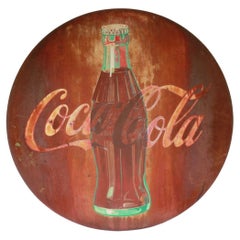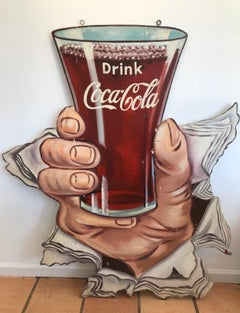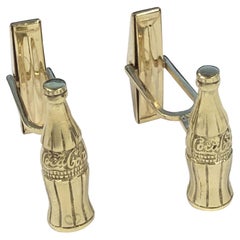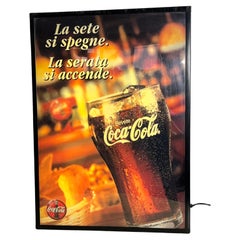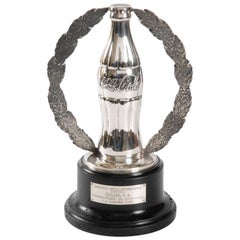Coca Cola Vintage
to
73
575
106
698
314
314
141
94
94
76
63
39
33
65
47
46
33
13
Sort By
70S COCA COLA POSTER
Located in Napoli, IT
Poster vintage con cornice Coca-Cola retrò pubblicità da collezione
Category
1970s Folk Art Coca Cola Vintage
Materials
Color
Rare Original "Coca Cola" Picnic Set, 1960s
By Coca Cola Bottling Co.
Located in taranto, IT
Extremely rare original coca cola picnic set, 1960s
It is a container inside which there are
Category
1960s Coca Cola Vintage
Materials
Metal
Vintage Coca Cola Sign
Located in Pittsburgh, PA
This original 1950s Coca-Cola sign has the perfect faded red look that gives it tons of character
Category
1950s American Industrial Coca Cola Vintage
Materials
Metal
Coca-Cola sign - Unique Hand-Painted Wood Coke Sign - "Drink Coca-Cola" c 1950s
Located in New York, NY
A vintage, one of a kind hand painted wooden sign ca. 1950s or 1960s for Coca-Cola Company
Category
Mid-20th Century Folk Art Coca Cola Vintage
Materials
Wood, Mixed Media
$3,500
H 57 in W 42 in D 0.5 in
Vintage Yellow Gold Coca Cola Presentation Cufflinks
Located in Chicago, IL
Circa 1970s 14k yellow Gold Coca Cola Bottle form cufflinks rumored to have been a presentation to
Category
1970s American Coca Cola Vintage
Materials
14k Gold, Yellow Gold
Vintage Coca Cola Backlit Advertising Panel 1980s
Located in Palermo, IT
Vintage Coca Cola backlit advertising panel 1980s.
It can also be hung because it has hooks.
Metal
Category
1980s Italian Coca Cola Vintage
Materials
Metal
Retro Silver Coca Cola Bottle Horse Trophy, Spain
Located in Pymble, NSW
A silver International Horse Trophy for 1970, Begano Spain as a Coca Cola bottle with cast wreath
Category
1970s Spanish Mid-Century Modern Coca Cola Vintage
Materials
Silver
1980's Coca Cola Classic Ice Bucket New Never Used Rare Collectible
By Coca Cola Bottling Co.
Located in San Diego, CA
A very collectible original Coca cola , Ice bucket never used in its box, foam plastic super cool
Category
20th Century American Post-Modern Coca Cola Vintage
Materials
Plastic
Original 1960s Coca Cola ice bucket by Smidt-imex
Located in Meulebeke, BE
USA / 1960 / ice bucket / Coca Cola / plastic / Mid-century / Vintage
A stylish original Coca Cola
Category
1960s Belgian Mid-Century Modern Coca Cola Vintage
Materials
Plastic
American Original Coke Coca Cola 1940's Advertising Serving Tray 321-K
By Coca Cola Bottling Co.
Located in San Diego, CA
rare original vintage coke Coca Cola serving tray very collectible , circa 1940's Made in The USA
Category
20th Century American Art Deco Coca Cola Vintage
Materials
Metal
$325
H 1.25 in W 13.25 in D 10.5 in
Lithograph Lenin Coca-Cola, by Alexander Kosolapov (b. 1943) Numbered, Framed
Located in Fort Lauderdale, FL
Lithograph Lenin Coca-Cola, by Alexander Kosolapov (b. 1943) Numbered, Framed
Metallic gold ink
Category
Late 20th Century American Modern Coca Cola Vintage
Materials
Paper
$3,675
H 46 in W 53 in D 4 in
Naturalistic Coca-Cola Barn Farm Rural Landscape Painting
Located in Houston, TX
Naturalistic painting of a rural farm landscape with a barn that has the iconic red Coca-Cola sign
Category
Late 20th Century Naturalistic Coca Cola Vintage
Materials
Canvas, Acrylic
Vintage Pop Art Coca- Cola Bottle Embedded Lucite Sculpture
Located in North Miami, FL
This pop art vintage lucite sculpture is a coca cola small bottle encased and embedded in a lucite
Category
1970s American Modern Coca Cola Vintage
Materials
Glass, Lucite
$671 Sale Price
25% Off
H 10 in W 4 in D 4 in
One-of-a-kind cool Coca-Cola cooler from the 1950s. in white and red colors.
By Coca Cola Bottling Co.
Located in Mexico, DF
This is a beautiful and rare vintage metal cooler for Coca-Cola bottles from the 1950s. (Drink Coca
Category
1950s Mexican International Style Coca Cola Vintage
Materials
Chrome, Sheet Metal
$920
H 14.77 in W 12.21 in D 18.71 in
1960s German Vintage Advertising Metal Coca-Cola Stadium Cooler & Bottle Carrier
Located in Nuernberg, DE
This vintage metal Coca-Cola vending tray, in red and white, was used in the 1960s in Germany to
Category
1960s German Modern Coca Cola Vintage
Materials
Metal
$800 / set
H 6.13 in W 18.5 in D 8.5 in
Original Vintage Advertising Poster Spanish Fashion Contest Coca Cola Model Art
Located in London, GB
below with the Coca Cola logo and sponsorship caption: Elegancia y Coca Cola / Elegance and Coca Cola
Category
1960s Spanish Coca Cola Vintage
Materials
Paper
$1,031
H 39.38 in W 27.56 in D 0.04 in
"Coca-Cola and Coffee", Original 1949 Painting, Important Industrial Design
Located in Philadelphia, PA
watercolor rendering of a short-lived Coca-Cola/coffee vending machine was painted by Carl Otto in 1949. The
Category
1940s American Art Deco Coca Cola Vintage
Materials
Paint
$10,000 Sale Price
20% Off
H 38 in W 26 in D 1 in
Vintage Poster Olympic Games Moscow Sponsored by Coca Cola - 1980
Located in Roma, IT
Vintage Poster Moscow 1980, sponsored by Coca Cola.
Offset print.
58 x 43 cm ; no frame 50 x 35
Category
1980s Contemporary Coca Cola Vintage
Materials
Offset
$357
H 22.84 in W 16.93 in D 0.04 in
Large 4' Foot Coca-Cola Light Up Steel Marquee Clock, Circa 1960
Located in Van Nuys, CA
Transport yourself to the 1950s with this iconic 4' tall Coca-Cola Collectible Wall Clock. Crafted
Category
1950s Coca Cola Vintage
Materials
Steel
$2,925 Sale Price
35% Off
H 40.5 in W 50 in D 6 in
Coke Bottle in Lucite Sculpture, Coca Cola, United States, 1970's
By Andy Warhol
Located in San Juan Capistrano, CA
Coke Bottle in Lucite Sculpture, Coca Cola, United States, 1970's.
Category
20th Century American Modern Coca Cola Vintage
Materials
Acrylic, Lucite
$300 Sale Price
20% Off
H 9 in W 3 in D 3 in
1960s Coca-Cola Trade Sign 'Drugs & Soda' From WPB, Florida Clematis Street
Located in West Palm Beach, FL
1960s Coca-Cola Trade Sign: 'Drugs & Soda'
Salvaged from a pharmacy on Clematis Street, West Palm
Category
1960s American Coca Cola Vintage
Materials
Metal
$7,600 Sale Price
20% Off
H 55.5 in W 46 in D 8 in
Pop Art "Coca Cola"/ Coke Bottle in Lucite Sculpture / Paperweight
Located in San Diego, CA
A really fun pop art "Coca Cola" / Coke bottle in lucite sculpture / paperweight, circa 1970s. The
Category
Mid-20th Century American Mid-Century Modern Coca Cola Vintage
Materials
Lucite
Mid-Century Coca Cola Delivery Truck by Buddy L, C1960
By Buddy L. 1
Located in Port Jervis, NY
Fabulous buddy L Coca Cola delivery truck with aluminum hand truck from the late fifties early
Category
1960s American Mid-Century Modern Coca Cola Vintage
Materials
Aluminum, Steel
Folk Art Bag, Made by Coca Cola Crown Caps, Burkina Faso, Late 80’s
Located in Milan, IT
A small funny and unusual folk Art bag, made by Coca Cola crown caps wired together. Burkina Faso
Category
Late 20th Century Burkinabe Coca Cola Vintage
Materials
Metal
1984 Original advertising poster for Coca Cola and the Summer Olympic Games
Located in PARIS, FR
A very beautiful poster, with the futuristic look realized at the request of Coca-Cola to celebrate
Category
1980s Coca Cola Vintage
Materials
Paper
$1,191
H 18.51 in W 25.6 in
Two Chairs Cast Iron Marble-Top Table Coca-Cola Dinette Ice Cream Set Cafe Table
By John Salterini
Located in Rockaway, NJ
Mid-Century Modern red Coca-Cola cast iron base figural marble-top cafe table with two Salterini
Category
20th Century American Mid-Century Modern Coca Cola Vintage
Materials
Marble, Wrought Iron
$3,600 / item
H 29 in W 26 in D 21 in
A rare reproduction of the Coca Cola umbrella girls in a rustic red frame
Located in Houston, TX
A rare reproduction of the Coca Cola umbrella girls in a rustic red frame. Festoon art is
Category
1970s Unknown Mid-Century Modern Coca Cola Vintage
Materials
Wood
Coca Cola #4 1981 Signed Limited Edition Silkscreen on Arches paper
By Ching Jang Yao
Located in Rochester Hills, MI
Artist : C.J. Yao
Title: Coca Cola #4 - 1981
Screen Print, on Arches archival paper 22'' x 23.5
Category
1980s Abstract Coca Cola Vintage
Materials
Screen
$800
H 22 in W 23.5 in D 1 in
"Stoking the Engine", Painting for Coca Cola on "Uses of Coal" for 1949 Campaign
By Lyman Anderson
Located in Philadelphia, PA
engineer feeding the engine with a fresh supply of coal was commissioned by the Coca Cola Company for an
Category
1940s American Art Deco Coca Cola Vintage
Materials
Paint
$2,320 Sale Price
20% Off
H 13 in W 13 in D 0.1 in
Collectible Coca-Cola Special Edition Asian Chinese Bottles, a Set of 5
Located in Plainview, NY
A custom made special edition Coca-Cola set of 5 miniature glass bottles. Each bottle is
Category
Late 20th Century Chinese Chinoiserie Coca Cola Vintage
Materials
Glass
$680 Sale Price
20% Off
H 6 in W 7 in D 7 in
Friends: Central Park, Coca-Cola
By William Helburn
Located in New York, NY
This photograph is an edition of 50. See below for other editions available. All editions are signed by the photographer. Larger sizes may be available upon request.
Category
1950s Coca Cola Vintage
Materials
Archival Pigment
Headwall with Coca-Cola Can
By Wes Olmsted
Located in Buffalo, NY
An original pen and ink drawing by Westley "Wes" Olmsted. This work is currently featured in the exhibition Man of Extremes at Benjaman Gallery in Buffalo, NY.
Westley G. Olmsted ...
Category
1970s Modern Coca Cola Vintage
Materials
Ink, Paper
Mid-Century Restored Coca-Cola Soda Bottle 10¢ Vending Machine by Vendo C: 1956
Located in Los Angeles, CA
A Mid-Century 10¢ Coca-Cola 12 oz Soda Glass Bottle Vending Machine by Vendo Company, Kansas City
Category
Mid-20th Century Mid-Century Modern Coca Cola Vintage
Materials
Metal
$8,950 Sale Price
28% Off
H 59 in W 27.5 in D 21 in
Original Coca Cola "Our America #3 Motion Pictures vintage 1943 poster
Located in Spokane, WA
the Coca-Cola Bottling Company. This poster displays the benefits of American Motion Picture making on
Category
1940s American Modern Coca Cola Vintage
Materials
Offset
$280 Sale Price
20% Off
H 31.75 in W 22 in D 0.05 in
Vintage Lluminated Advertisement Coca-Cola 80s, Czechoslovakia
Located in Praha, CZ
Good original condition
Case is from bakelite, picture is under glass
Advertisement lights on 2 bulbs
Fully working.
Category
1980s Czech Mid-Century Modern Coca Cola Vintage
Materials
Glass, Bakelite
Bulldog Drummond and the Great Coca-Cola Mystery by Richard Merkin
By Richard Merkin
Located in Hudson, NY
An iconic mixed media example of Richard Merkin's art.
Bulldog Drummond and the Great Coca-Cola
Category
1960s Modern Coca Cola Vintage
Materials
Paper, Mixed Media
$14,500
H 51 in W 30 in
Vintage Coke Bottle Drinking Glass from Coca-Cola
Located in Hamburg, DE
Rare Collector's Item for Coke Collectors.
Additional information:
Materials: Glass
Item Type: Vintage, Antique or Pre-owned
Dimensions: 3.15ʺW × 3.15ʺD × 8.66ʺH
Condition: Good Con...
Category
20th Century Coca Cola Vintage
Materials
Glass
Vintage Coca - Cola Advertising Fan Cover. 1950 - 1959
Located in CADALSO, ES
Rare to find
Category
1950s German Mid-Century Modern Coca Cola Vintage
Materials
Metal, Aluminum
Archie and George with Coca Cola Screen Test
By Andy Warhol
Located in Santa Monica, CA
This is a 16mm film
With Archie, George Millaway
Written on box in Andy Warhol’s hand: Archie, MARY + (illegible word) George
b&w, silent, 100’
Footage of Archie (on left) and ...
Category
1960s Coca Cola Vintage
Materials
Film
Vintage Blue Coca-Cola Coke Sign Coney Island
By Mitchell Funk
Located in Miami, FL
Shipping should be around $100 - Nostalgic old Coney Island Coke signs with a glympse of the rollercoaster create a bold and powerful abstraction
Signed, dated, numbered lower righ...
Category
1970s Abstract Geometric Coca Cola Vintage
Materials
Photographic Paper, Inkjet
Advertising Glass Sign "Trink Coca Cola - Eiskalt". 1950 - 1959
Located in CADALSO, ES
Great condition
Category
Mid-20th Century German Mid-Century Modern Coca Cola Vintage
Materials
Glass
Advertising Glass Sign "Trink Coca Cola - Coke". 1950 - 1959
Located in CADALSO, ES
Great condition
Category
Mid-20th Century German Mid-Century Modern Coca Cola Vintage
Materials
Glass
American Contemporary Photo by M.K. Yamaoka - Coca-Cola Mural, Fayetteville
Located in Paris, IDF
Digital Photograph, ed. 3 of 9 HP Premium Satin Photo Paper with archival inks
Born in Japan in 1940 and educated at The Art Center College of Design in California, Michael K. Yamao...
Category
Late 20th Century Contemporary Coca Cola Vintage
Materials
Photographic Paper, Ink, Digital
Michael K. Yamaoka American Contemporary Photo by M.K. Yamaoka - Coca-Cola Mural, Fayetteville, 2011
$3,200 Sale Price
20% Off
H 36 in W 24 in D 0.1 in
Cold Beer (with coca cola sign) iconic photorealist lithograph, Signed/N Framed
By Robert Cottingham
Located in New York, NY
Two Color Offset Lithograph on Wove Paper by photo realist star Robert Cottingham
Pencil signed, titled and numbered from the edition of 150 on the front
This hand signed, titled and...
Category
1980s Photorealist Coca Cola Vintage
Materials
Lithograph
Malcah Zeldis Folk Art Gouache Painting Sports Basketball Arena Coca Cola Sign
Located in Surfside, FL
MALCAH ZELDIS
''Basketball'', 1988, gouache on paper
Hand signed and dated bottom right, titled in pencil on paper verso
Malcah Zeldis (born Mildred Brightman; 1931) is an Americ...
Category
1980s Folk Art Coca Cola Vintage
Materials
Paper, Gouache
"Ski Bunny" 1950s Illustration Watercolor and Guache Framed
Located in Wiscasset, ME
Signed Dick Williams, who was a major illustrator for companies like Coca Cola from the 1930s to
Category
1950s American Coca Cola Vintage
$1,600 Sale Price
27% Off
H 24 in W 21.5 in D 2 in
Marion Kramer spectacular 1930s old town scene
Located in San Francisco, CA
Marion Kramer spectacular 1930s old town
Depicting, vintage truck, Coca-Cola sign, regionalist
Category
1930s Coca Cola Vintage
Materials
Canvas, Oil
Andy Warhol 'You're in' Vintage Spray Painted Coke Bottle 1967
By Andy Warhol
Located in Miami, FL
ANDY WARHOL (1928-1987)
Coca-Cola glass bottle, metal bottle stopper and spray paint. Signed with
Category
1960s Contemporary Coca Cola Vintage
Materials
Glass, Spray Paint
$12,500
H 8 in Dm 2.23 in
Bottlecap Basket
Located in Darnestown, MD
This fabulous Bottle Cap Basket is true folk art. It is made of caps from Coca Cola; 7 Up and Dr
Category
1950s American Folk Art Coca Cola Vintage
Large Scale Mexican Folk Art Ceramic Angel Vessel
Located in Atlanta, GA
the estate of an Atlanta Coca Cola executive, who traveled the world for her job during the 1940s to
Category
1950s Mexican Folk Art Coca Cola Vintage
Materials
Stoneware
Red Side Drinks Table
Located in New York, NY
geometric side drinks table. Hue is a 'Coca-Cola' red. A great statement piece for a living room, lounge
Category
Late 20th Century Post-Modern Coca Cola Vintage
Materials
Plastic, Resin
Set of Six Brushed Aluminum #111 "Navy" Chairs by Emeco with Cushion
By Emeco
Located in San Diego, CA
submarines, today's 111 Navy Chair is an innovative collaboration between Coca-Cola and Emeco, Solving an
Category
Late 20th Century American Industrial Coca Cola Vintage
Materials
Aluminum
$1,800 / set
H 34 in W 15.5 in D 19.5 in
After Alberto Giacometti Bronze andirons
By Alberto Giacometti
Located in Chamblee, GA
late 1970's, unsigned.
We acquired them from the estate of a local Coca-Cola executive. The home
Category
1970s American Modern Coca Cola Vintage
Materials
Bronze, Iron
Original "Our America, Transportation Creates New Wonders" 1943 vintage poster
Located in Spokane, WA
Transportation has two variations produced by Coca-Cola to feature the future of modern air travel. This is a
Category
1940s American Modern Coca Cola Vintage
Materials
Offset
$440 Sale Price
20% Off
H 22.25 in W 32 in D 0.05 in
Andy Warhol Velvet Underground record art
By Andy Warhol
Located in Brooklyn, NY
Kansas City. Pop Art. Coca Cola. 1960s.
Category
1970s North American Coca Cola Vintage
Materials
Other
' Cola Café ' 1981 Limited Edition Archival Pigment Print
By Alain Le Garsmeur
Located in London, GB
more details.
1980s 1980 80s USA youth kids weird odd fun food drink coca cola pepsi red doll shop pop
Category
1980s Modern Coca Cola Vintage
Materials
Archival Pigment
Original "Our America, #4, the Future for Electrical Power" vintage poster
Located in Spokane, WA
Original Coca-Cola: Our America Electricity #4, original vintage poster, archival linen backed
Category
1940s American Modern Coca Cola Vintage
Materials
Offset
$475
H 22 in W 32 in D 0.05 in
Collection of Worldwide Traveler's Hand Carved Folk Art Masks
Located in Atlanta, GA
earlier. We purchased the estate of an Atlanta Coca Cola executive, who traveled the world for her job
Category
1950s Balinese Folk Art Coca Cola Vintage
Materials
Wood
- 1
- ...
Get Updated with New Arrivals
Save "Coca Cola Vintage", and we’ll notify you when there are new listings in this category.
Coca Cola Vintage For Sale on 1stDibs
Find many varieties of an authentic coca cola vintage available at 1stDibs. A coca cola vintage — often made from metal, ceramic and plastic — can elevate any home. There are many kinds of the coca cola vintage you’re looking for, from those produced as long ago as the 20th Century to those made as recently as the 20th Century. When you’re browsing for the right coca cola vintage, those designed in Mid-Century Modern, Industrial and Folk Art styles are of considerable interest. Coca Cola Bottling Co., Kathrine Baumann and St. Thomas Metal Signs each produced at least one beautiful coca cola vintage that is worth considering.
How Much is a Coca Cola Vintage?
A coca cola vintage can differ in price owing to various characteristics — the average selling price 1stDibs is $1,200, while the lowest priced sells for $75 and the highest can go for as much as $100,000.
Questions About Coca Cola Vintage
- 1stDibs ExpertOctober 30, 2024Many kinds of Coca-Cola items are potentially worth money. Vintage and antique advertising signs for the brand are popular among collectors, as are promotional pieces like trays. There is also a market for some vintage Coca-Cola drinking glasses and even for select bottles. How much Coca-Cola collectibles sell for depends on their age, type, condition and whether or not they are limited edition items. A certified appraiser or knowledgeable antique dealer can assist you with determining how much any pieces you own are worth. On 1stDibs, shop a variety of Coca-Cola collectibles.
- 1stDibs ExpertApril 5, 2024Haddon Hubbard Sundblom painted the Coca-Cola Santa Claus. He unveiled his first depiction of the now-iconic holiday figure in 1931. Over the next 33 years, he continued to revise the figure in fresh advertisements for the soft drink company. Explore a variety of Haddon Hubbard Sundblom art on 1stDibs.
More Ways To Browse
1988 Or 1989 Number810244 Howard Milleriller Clocks
Cartier Or Boucheron Clock
Hand Carved Mahogany
Post Modern Side Table
Vintage Industrial Collectables
Vintage Electrical
Collectables Miniature
Cream Dining Table
Used Time Clock
Vintage And Antique Ceramics
Antique And Vintage Glass Ceramics And Serveware
Bottle Stopper
Crate Box
Shell On Stand
Silver Horses
Used Gaming Machines
Mexico Vessel
Champagne Bottle


